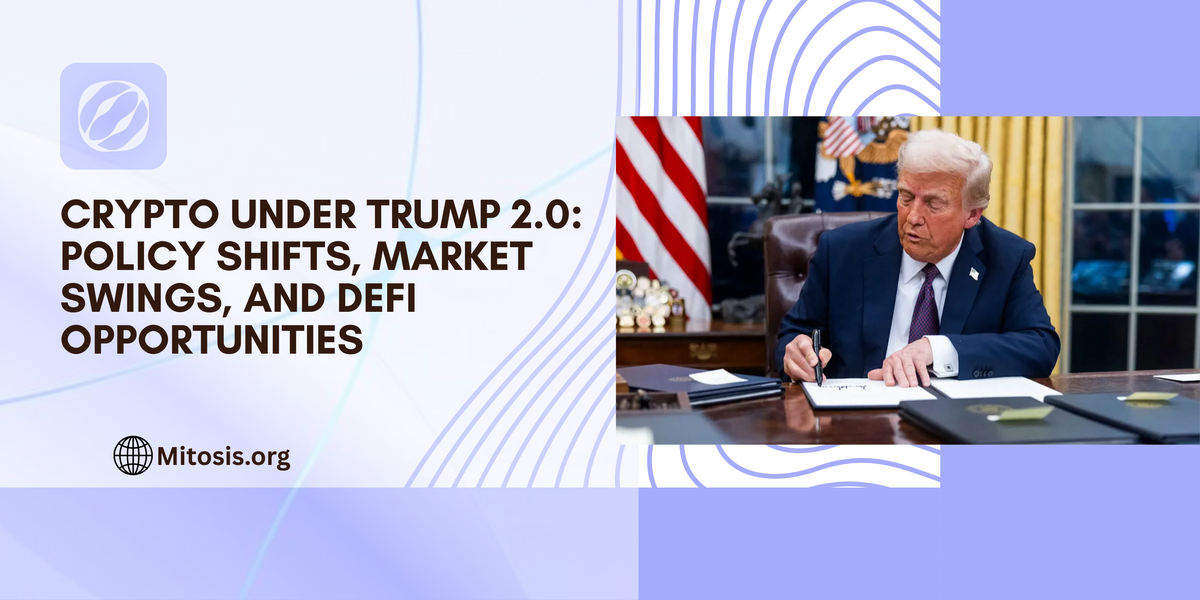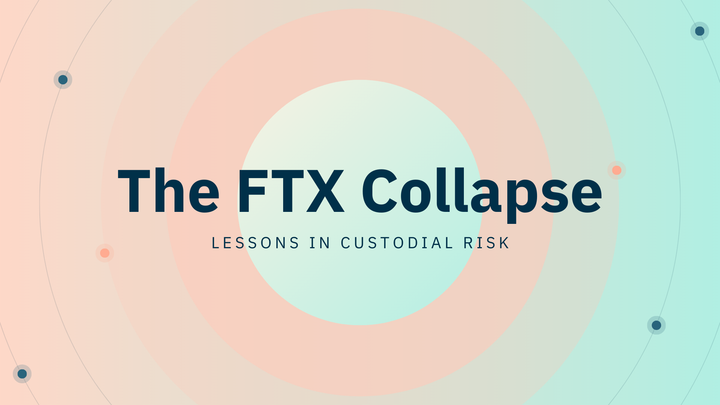Crypto Under Trump 2.0: Policy Shifts, Market Swings, and DeFi Opportunities

Under President Trump’s 2025 administration, cryptocurrency policy has shifted dramatically toward support and integration with national financial strategy. Key measures include an executive order on January 23, 2025, backing “responsible growth” of digital assets. See The White House, the establishment of a Strategic Bitcoin Reserve on March 6 to cement U.S. leadership in digital currency, and the repeal of restrictive accounting guidance by the SEC. See Winston & Strawn. Trump’s trade tariffs and tax reforms have also injected volatility into crypto markets, sparking price swings and exchange capitalization shifts. Meanwhile, energy incentives for mining under Trump‑backed policies have made the U.S. a global hub for Bitcoin mining, despite local community pushback, The Guardian. Crypto-friendly rule‑making and a working group on digital assets signal continued industry backing, while opaque Trump family investments in World Liberty Financial raise conflict‑of‑interest concerns. See CBS News. DeFi platforms like Mitosis stand to benefit from these policies by integrating regulated digital assets into cross‑chain liquidity frameworks.
Introduction: Trump’s Crypto Pivot in 2025
Donald Trump’s second term has seen a stark reversal from prior federal skepticism toward digital assets. On January 23, 2025, he issued an executive order titled “Strengthening American Leadership in Digital Financial Technology,” directing agencies to support blockchain and cryptocurrency growth across all sectors. This order rescinded Biden-era restrictions, such as SAB 121, to clear the way for banks and payment firms to engage with crypto freely. See Winston & Strawn,
Trade Tariffs and Crypto Volatility
Trump’s renewed emphasis on trade tariffs, particularly on China, has ripple effects in crypto. His 2025 tariff hikes on Chinese imports injected market uncertainty, driving Bitcoin (BTC) volatility as investors hedged against broader economic risks. According to Medium analysis, tariff announcements often triggered immediate sell‑offs on major exchanges, with capitalization dropping an average of 4% on announcement days. See https://www.winston.com/en/blogs-and-podcasts/non-fungible-insights-blockchain-decrypted/president-trumps-sweeping-executive-order-on-digital-assets-and-the-repeal-of-sab-121?
Tariffs “Pump and Dump” Exchange Caps
A Medium report finds that each new tariff wave correlates with a surge in BTC volatility index (BVOL) by 12% within 24 hours, followed by a 6% drop in exchange market caps over the next week . This “pump and dump” pattern underscores how macroeconomic policy can directly affect on‑chain liquidity and trader sentiment.
Trade Wars to Tax Breaks: Shaping Cryptocurrency
Trump’s 2017 and 2025 tax reforms granted generous incentives for tech and energy sectors, indirectly benefiting the crypto industry. Lower corporate tax rates (21% vs. 35%) increased venture capital for blockchain projects, while tax credits for energy production spurred mining operations in states like Texas . These policies continue under his 2025 administration, embedding crypto into the broader economic agenda. See https://www.winston.com/en/blogs-and-podcasts/non-fungible-insights-blockchain-decrypted/president-trumps-sweeping-executive-order-on-digital-assets-and-the-repeal-of-sab-121?
January 23 EO: “Responsible Growth” of Digital Assets
The January 23 EO mandates federal agencies to review and rescind outdated crypto regulations, encouraging innovation while asserting U.S. dollar sovereignty The White House. It also prohibits central bank digital currencies (CBDCs), signaling a preference for market‑driven crypto solutions over government‑issued tokens The White House.
Establishing a Strategic Bitcoin Reserve
On March 6, 2025, Trump signed EO 14233 to create a Strategic Bitcoin Reserve and U.S. Digital Asset Stockpile, funded by seized or forfeited crypto assets, positioning the U.S. as a leader in national digital asset strategy The White House. This move parallels gold and oil strategic reserves, granting the government a direct stake in crypto markets.
SEC Deregulation: Repealing SAB 121
The SEC, under Trump’s directives, rescinded SAB 121—an accounting rule that had barred banks from holding or transporting crypto assets on behalf of clients Winston & Strawnthe . This repeal unlocks banking participation in custody and settlement, enhancing institutional crypto flows and laying groundwork for DeFi integration.
Crypto Working Group and Regulatory Clarity
Trump’s EO sets up a Digital Asset Working Group tasked with crafting federal rules by Q3 2025, aiming to clarify token classification, AML/KYC standards, and staking product regulations Carlton Fields. Clear guidelines are expected to reduce compliance costs and accelerate DeFi innovation on platforms like Mitosis’s Matrix Vaults.
Mining Boom and Community Backlash
Leveraging energy incentives, Trump’s policies have fueled a mining surge: 2.3% of U.S. electricity now drives crypto mining, with 137 commercial hubs operating nationwide. See The Guardian. While boosting onshore hash power, this expansion has sparked local noise and environmental complaints, notably in Texas communities facing 100 dB noise levels from data centers.
Bitcoin Price Performance in Trump’s First 100 Days
| Date | BTC Price (USD) | Change (%) |
|---|---|---|
| Inauguration Day (Mar 20) | 109,225 | — |
| Day 30 | 104,600 | –4.2% |
| Day 60 | 100,800 | –7.7% |
| Day 100 | 98,040 | –10.2% |
Source: MarketWatch analysis of Trump’s first 100 days performance MarketWatch.
Trump Family’s Crypto Ventures and Conflicts
Recent CBS News reporting reveals the Trump family’s net worth soared by $2.9 billion in 2025, partly due to their World Liberty Financial exchange and $WLFI token offerings, raising conflict‑of‑interest alarms. See CBS News. The government's pauses on federal crypto probes under the administration further exacerbate ethical concerns.
Trump Media’s Crypto ETF Plans
Reuters reports that Trump Media is pivoting toward crypto ETFs, planning products that blend digital assets with traditional portfolios, reflecting the president’s bullish stance on crypto’s investment potential. See Reuters. Approval of such ETFs could drive mainstream adoption and liquidity, benefitting platforms like Mitosis through increased tokenized asset inflows. See https://www.reuters.com/business/finance/trump-media-pushes-forward-with-pivot-crypto-etf-plans-2025-04-22/?
Implications for DeFi: Mitosis Integration
With clearer regulations and institutional support, DeFi protocols like Mitosis can onboard formerly hesitant investors. Mitosis’s Matrix Vaults can house strategic bitcoin alongside tokenized RWAs, while Ecosystem‑Owned Liquidity (EOL) governance can allocate digital asset stockpiles via on‑chain voting . This synergy catalyzes new yield strategies anchored by government reserves.
Future Outlook: Crypto Under Trump’s 2025 Policies
Looking ahead, Trump’s emphasis on digital asset leadership suggests continued executive actions to streamline regulation, incentivize domestic mining, and foster public‑private partnerships in blockchain infrastructure. These policies may catalyze a U.S.‑centric crypto ecosystem, reshaping global power dynamics in digital finance.
Conclusion
President Trump’s 2025 tenure marks a pivotal era for digital assets. Through executive orders removing regulatory barriers, creating a Strategic Bitcoin Reserve, and empowering federal working groups, his administration has strongly signaled support for cryptocurrency innovation. While market volatility from trade policies and ethical debates around family ventures pose challenges, platforms like Mitosis stand ready to integrate these developments into programmable liquidity and cross‑chain interoperability, driving the next wave of DeFi expansion.
🔗Links:



Comments ()